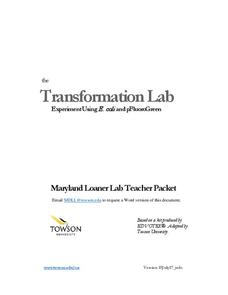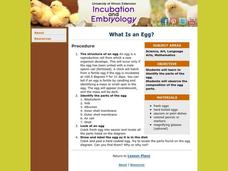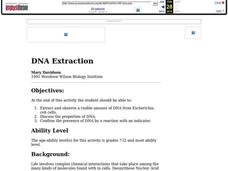Richland County School District One
Incubating Quail Eggs
Students incubate quail eggs. In this biology lesson, students observe the development of the embryo, monitor, turn, weigh the eggs, and observe the hatching of the chicks. They identify the structures within a fertilized egg and their...
Curated OER
Hatching Chickens
Learners consider the concept that much can be learned from the natural world by observation. They observe the incubation and hatching of chicken eggs in the classroom and discuss the needs of living things.
Curated OER
The Shape of Things
Sixth graders read and discuss information regarding the shape and attributes of an eggshell. In this shape of things activity, 6th graders gather relevant information that pertains to the incubation and formation of an eggshell. ...
Curated OER
Your Body: Bacteria Incubator
Students explain the benefits and harm caused by bacteria in the body. In this biology lesson plan, students observe bacterial growth in the lab. They explain why anti-bacterial soap may not be beneficial for the human body.
Towson University
Transformation Lab
Transform your class' understanding of genes and antibiotic resistance with the Transformation Lab. Junior geneticists create and observe their own resistant strains of E. coli through research, discussion, and experimentation. The...
Curated OER
Your Body: A Bacteria Incubator!
Students use string, a petri dish, water, wipes, and other materials to collect bacteria from their body. In this bacteria lesson plan, students use ingredients to collect bacteria, observe it, predict what will happen over time, and...
Curated OER
Hatching chickens
Students recognize the need for gentle care of eggs. In this chicken hatching lesson, students observe the process of incubating eggs for hatching. Students find the materials needed to properly care for the chicks. Students complete a...
Serendip
Is Yeast Alive?
Through two investigations, life science learners determine whether or not yeast is alive. They perform tests for metabolism by providing sugar and observing if gas is produced as a byproduct. They incubate some of the sample for at...
Curated OER
Preparation and Staining of Mammal Cells to View Sister Chromatids
Observation of sister chromatids is possible as students culture and stain mammal tissue cells.
Curated OER
How Can We Observe Genetic Variation Within a Species?
Young scholars observe intra-species variation by completing standard microbial streaking procedures. They collect data from which they draw observations and complete a worksheet.
NOAA
Watch the Screen!
Can a sponge cure cancer? Life science pupils visit the drugstore under the sea in the fifth lesson of six. Working groups research the topic then get hands-on experience by testing the inhibiting effects of several plant extracts on E....
Curated OER
Hatching Chickens
Students observe how chickens hatch. In this life cycles lesson, students read the book Hatching Eggs: A Step by Step Guide and use an incubator to hatch the eggs. Students observe the chicks hatching and take care of the chicks by...
Curated OER
Hatching Chickens
Young scholars observe chickens hatching in a classroom incubation environment In this egg-hatching lesson plan, students make observations of the hatching process and later care for the hatched chickens.
Curated OER
DEMONSTRATING AN EPIDEMIC
Students experience a small scale "epidemic," demonstrating the ease with which disease organisms are spread, and enables the student to determine the originator of the "epidemic." They transfer live bacteria by hand contact, then...
Curated OER
DNA Extraction
Students extract and observe a visible amount of DNA from Escherichia. coli cells. They discuss the properties of DNA. Confirmation of the presence of DNA by a reaction with an indicator is confirmed within this lesson. Many hands-on...
Curated OER
Plant Growth - Light and Shade
Third graders conduct an experiment comparing plants. In this plant lesson, 3rd graders plant seeds and grow two varieties of plant comparing the light needed for it to grow. Students make predictions and record their observations....
Curated OER
Potato Petri dish
Learners participate in an experiment to understand how germs grow. In this potato experiment students use their hands to touch a potato and leave it to see what grows on it. Learners also observe a disinfected potato piece. Students the...
Curated OER
Predicting the Growth of Microorganisms
Students determine where microorganisms might be found around their school. In this scientific investigation lesson, students collect cultures from various locations and place these in petri dishes. They incubate the cultures to see if...
Curated OER
Embryo Development
Students observe the development of a chicken embryo. In this biology lesson, students compare and contrast the development of human and chick embryo. They make a chart and explain their findings to the class.
Curated OER
The Shape of Things
Students study the natural incubation of hens and the important characteristics of the egg shell. They perform experiments to test the strength of the dome shape of an egg and prove that an eggshell has pores to allow air to pass. ...
Curated OER
Demonstrating an Epidemic
Young scholars use an experiment that allows them to experience a small scale "epidemic", demonstrating the ease with which disease organisms are spread. Students determine the originator of the epidemic. They transfer live bacteria by...
Curated OER
What Is an Egg?
Students identify the parts of the egg and observe the composition of the egg parts.
Curated OER
How To Culture Bacteria in the Laboratory
Students participate in an experiment in which they culture bacteria in a lab setting. They record their observations and analyze the data. They answer comprehension questions to end the lesson plan.
Curated OER
DNA Extraction
Students are able to extract and observe a visible amount of DNA from Escherichia coli cells. They discuss the properties of DNA. Students confirm the presence of DNA by a reaction with an indicator.

























